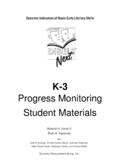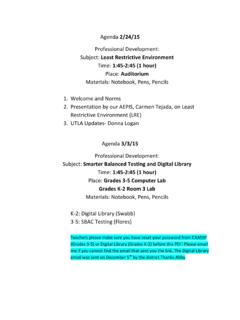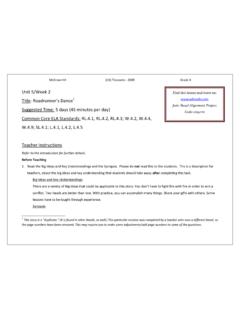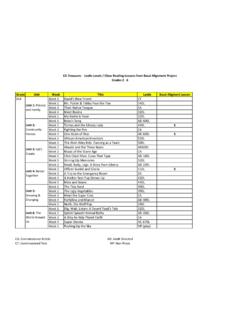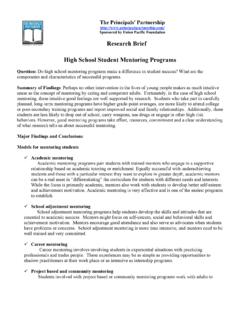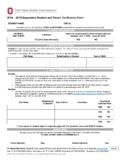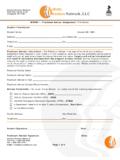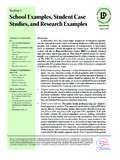Transcription of DIBELS Next Student Materials - Chase Street …
1 DIBELS benchmark assessment DIBELS next Student Materials . Fourth Grade/Benchmark Assessment Roland H. Good III. Ruth A. Kaminski with: Kelli Cummings, Chantal Dufour-Martel, Kathleen Petersen, Kelly Powell-Smith, Stephanie Stollar, and Joshua Wallin Dynamic Measurement Group, Inc.. DIBELS is a registered trademark of Dynamic Measurement Group, Inc. Visit our website at Revised 5/17/10. How to Make Dill Pickles Would you like to make a tasty treat that's fun to eat anytime? Try making your own dill pickles! Start by gathering the ingredients and kitchen equipment. For storing the pickles, you will need a quart jar with a tightly fitting lid. For making the pickle juice, you will need a deep saucepan and a measuring cup that shows cups and ounces. The main ingredients for this recipe are cucumbers and dill weed. Both of these are easy to grow if you are lucky enough to have a vegetable garden. If you don't have a garden, you can find them in the produce department at the grocery store.
2 Two other produce items you will need are fresh garlic and a small onion about the size of a golf ball. You will also need salt and sugar to add flavor to the pickles. The liquids you will use to fill the jar are water and white vinegar. The purpose of the vinegar is to keep the cucumbers from spoiling. It will also add that delicious sour taste that makes pickles fun to eat. To make your pickles, slice five cucumbers lengthwise and stand the slices in the quart jar. next , create the juice that will flavor the pickles. Pour nine ounces of water and five ounces of vinegar into the saucepan. Peel the onion and one clove of garlic, and add them to the liquid. Then put in two heads of dill weed. Add one fourth teaspoon of sugar and one tablespoon of salt. For the next step, ask an adult to help you. Heat the pickle juice over medium high heat until it reaches a boil. Then pour it over the cucumbers and put the lid on the jar. Let the pickles cool overnight before storing them in the refrigerator.
3 Your pickles will be ready to eat in about ten days. Use them on burgers or sandwiches, or enjoy a pickle all by itself for a cold, crunchy treat! DIBELS Benchmark Assessment Page 1. Oral Reading Fluency G4/Benchmark Water Skiing This morning I attended my first day of water skiing lessons. We began by putting on our skis on dry land. Kimberly, our instructor, demonstrated how to adjust the ski bindings, the attachments that hold the skis to your feet. She said that the bindings should be tight enough to hold the feet securely but loose enough to come off instantly in a fall. While still on dry land, I stood and gripped a rope while Kimberly gently tugged on it. This was to give me an idea of what it would feel like to be pulled by the boat. Kimberly also taught us to use hand signals. She explained that a thumbs up meant faster and thumbs down meant slower. We also learned to shout Hit it when we were ready to ski. After reviewing the basics, Kimberly thought that we were ready for our first attempt.
4 We moved into the water and Kimberly instructed us to get into position by putting our knees to our chests. She described how the tips of the skis should be parallel to each other and should stick out of the water. When it was my turn, Kimberly reminded me to lean back and relax. I did my best, but I tumbled over and swallowed some water. I. laughed as I got myself back into position. Kimberly said I had done fine for a first try. She suggested that I simply allow the boat to pull me out of the water. This advice helped a lot. On my next attempt I stood up on my skis. On my third attempt, I skied about twenty yards before I fell. By the end of the afternoon, I could ski about a hundred yards without falling. Even though I stayed directly behind the boat where the water is the smoothest, I was thrilled by the excitement of learning to water ski. I'm eager for tomorrow's lesson, because I want to learn to jump over waves. With Kimberly's help, I'm sure I'll be able to do it.
5 DIBELS Benchmark Assessment Page 2. Oral Reading Fluency G4/Benchmark The Power of Magnets Long ago, a shepherd stepped onto a large black rock and found he couldn't move his feet or his walking staff. An invisible power held the nails in his shoes and the metal tip of his staff to the rock! He pulled his feet free and stepped away. Then he dug up the strange rock and showed it to his neighbors. The rock he had found was lodestone, a natural magnet. The Greeks started telling this story four thousand years ago. That was when people first learned that lodestone attracted anything that had iron in it. Soon stories about the power of the rock spread. Some said that a thin piece of the stone floating on water would always point north. That story was true, but others were not. Some people claimed that the rock could heal the sick. Many said that ships lost at sea were wrecked by islands made of lodestone. They said that by pulling on nails and other metal parts, the islands led ships off course and made them crash on the rocks.
6 Many years later, people began to learn the facts about magnets. They found they could use electricity to create a magnetic effect. One early scientist even figured out that a compass points north because the Earth itself is a giant magnet. Today we know much more about magnets, and we use them in many ways. In medical machines, magnets let doctors look at bones and organs inside the human body. They help make doorbells ring, and they help computers store information. They even help us learn about space. The Rover, a small vehicle that rolled over the surface of Mars, used magnets to collect dust for scientists to study. Now some inventors are working on ways to use magnets to make robots move. Others think magnetic fields can protect a spacecraft from the sun's rays. Thousands of years after the first magnet was found, we are still learning about the power of magnets. DIBELS Benchmark Assessment Page 3. Oral Reading Fluency G4/Benchmark Your Nervous System Every day you use your brain to think and to solve problems, but did you know that your brain is constantly doing jobs you never even think about?
7 Your brain makes sense of everything your body experiences. It also directs everything your body does. The brain is part of your nervous system, which also contains your spinal cord and your nerves. This system allows messages to be sent back and forth between the brain and other parts of your body. Your brain is at the top of your nervous system. It is very soft, and is protected by the hard bones of your head. Connected to your brain is your spinal cord, a long bundle of nerve tissue. It threads through your spine and then branches out to connect to other nerves in your body. The nerve cells are shaped like long, thin threads. They line up end to end and extend from the spinal cord in your back to every part of your body. The nerve endings in your skin and organs are activated by touch and other sensations. The nerve endings pass the message to the next nerve in line. In a flash, the message is relayed from nerve to nerve until it reaches your brain.
8 The message gives your brain information about what you are touching or sensing. The brain sends back a command telling your body what action to take. If the feeling is harmful, the brain may direct your hand to pull back. If dust blows into your eye, your brain gets the message and instantly directs your eye to blink. Different parts of the brain handle messages of different kinds. Some parts of your brain control automatic activities in your body, such as your heartbeat and breathing. Other parts direct movement and balance. The front part of your brain thinks and holds memories. It also receives information from your five senses. Your brain and nerves make you aware and help you live and enjoy life. In short, your nervous system helps make you who you are. DIBELS Benchmark Assessment Page 4. Oral Reading Fluency G4/Benchmark The Story Tree When you have a lot of relatives you've never met, it's hard to keep them all straight. At least, that's how it seemed to Joseph as he listened to his grandfather's stories.
9 The stories were about Joseph's ancestors from long ago. Many had come to America from Eastern Europe. Some had sailed on the Mayflower! Others faced dangers as they went west in covered wagons. Even though their names were unfamiliar, Joseph loved hearing about their adventures. One day, Joseph decided to record the names of the people in the stories. Each time Grandpa mentioned a relative, he wrote the name on an index card. If Grandpa knew when the person was born or died, he recorded that, too. On the back, he added interesting details from the person's life. You know, we could lay out those cards so you could see how all these people are connected, suggested Grandpa. He helped Joseph match cards that named husbands and wives or brothers and sisters. Soon, there were clusters of cards scattered everywhere. It seemed very complicated, and it was clear that Joseph felt more confused than ever! Grandpa laughed. Maybe you should make a card for yourself and arrange the rest to show how everyone is related to you, he said.
10 That's a great idea! said Joseph. I'll lay out the cards to show our family tree.. First Joseph made a card with his own personal information. Then he rolled out a long piece of brown wrapping paper and drew a tree trunk and branches. He placed his card on the trunk and tried to connect his card to the rest. Right away, he saw that he needed to make cards for his mom and dad to put on the lowest limbs of the tree. Each row of cards above those would represent an earlier generation. With Grandpa's help, Joseph soon found the right location for each of his cards. It's like looking at a giant story, said Joseph as he stood back admiring his tree. That's exactly what it is, said Grandpa. This tree is the story of you! . DIBELS Benchmark Assessment Page 5. Oral Reading Fluency G4/Benchmark A Grand Old Clock One summer morning, a team of rope climbers put on their gear and tackled an unusual assignment. They weren't climbing a rocky cliff in the wilderness.

